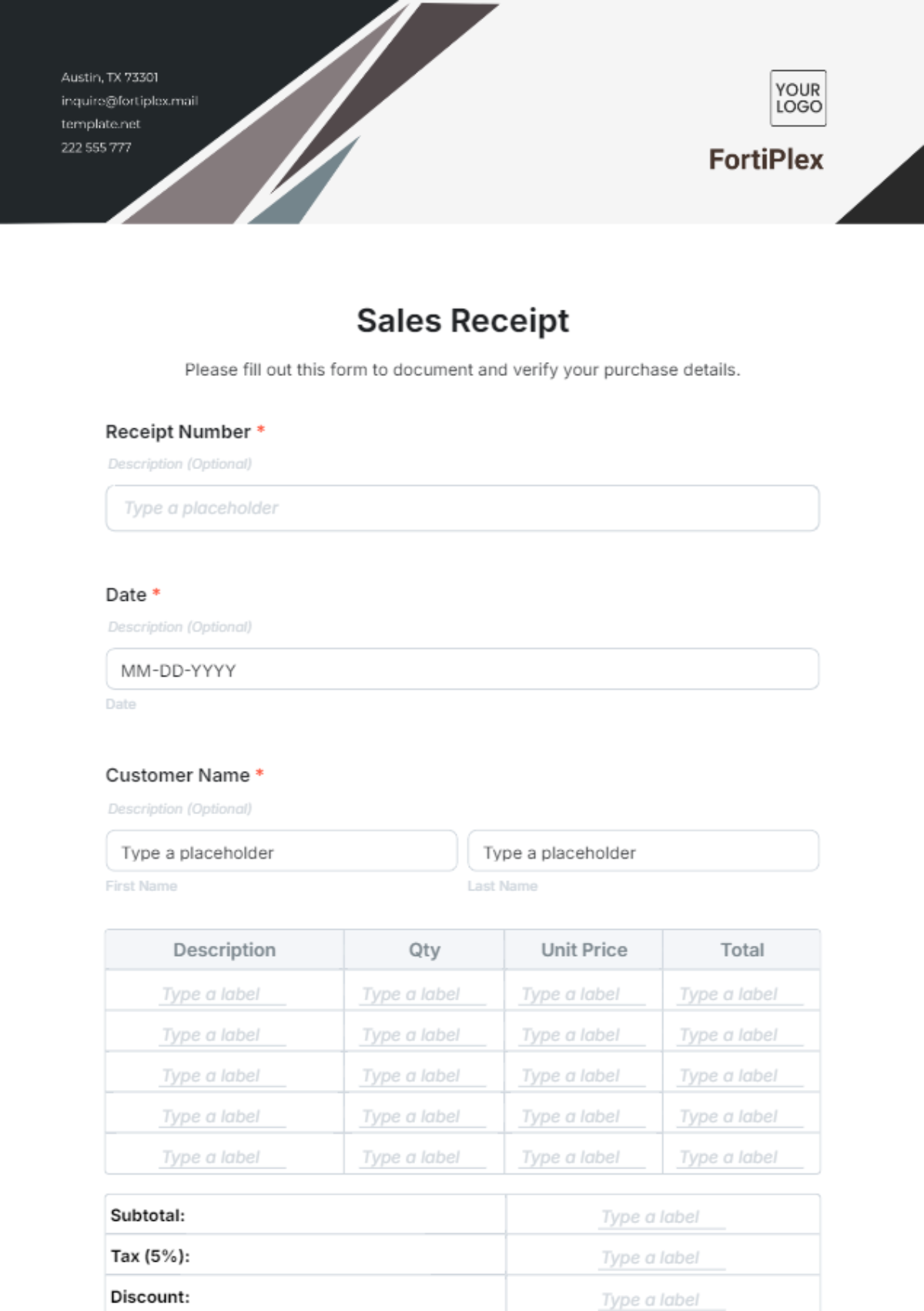Sales Data Management Strategy Document
I. Introduction
A. Purpose
The purpose of this Sales Data Management Strategy Document is to establish a comprehensive framework for the efficient and effective management of sales data within [Your Company Name]. By defining clear processes, protocols, and responsibilities, this document aims to ensure that sales data is collected, stored, analyzed, and utilized in a manner that maximizes its value for driving business growth and enhancing customer satisfaction.
B. Scope
This document encompasses all aspects of sales data management within [Your Company Name], including but not limited to:
Data collection from various sources such as CRM systems, POS terminals, online platforms, and offline transactions.
Data storage and organization using both cloud-based and on-premises infrastructure, with an emphasis on security and accessibility.
Data analysis and reporting using advanced analytics techniques to derive actionable insights and support strategic decision-making.
Data security and compliance measures to protect sensitive information and ensure compliance with relevant regulations and industry standards.
C. Audience
This document is intended for a wide range of stakeholders involved in sales data management within [Your Company Name], including:
Sales managers and representatives responsible for generating and capturing sales data.
Data analysts and business intelligence professionals tasked with analyzing and interpreting sales data to extract actionable insights.
IT administrators and developers responsible for maintaining data infrastructure, implementing data management tools, and ensuring data security.
Compliance officers and legal personnel responsible for ensuring that sales data management practices comply with relevant regulations and industry standards.
Senior executives and decision-makers who rely on sales data to inform strategic planning and business operations.
II. Executive Summary
A. Overview
In today's highly competitive [industry] industry, the effective management of sales data is critical to achieving business success. [Your Company Name] recognizes the strategic importance of harnessing the power of sales data to drive growth, enhance customer experiences, and maintain a competitive edge in the market. This Sales Data Management Strategy sets forth a roadmap for achieving these objectives through the implementation of best practices in data collection, storage, analysis, and utilization.
B. Key Objectives
This Sales Data Management Strategy aims to achieve the following key objectives:
Optimize data collection methods to ensure comprehensive coverage of all sales channels and touchpoints, enabling a holistic view of customer interactions and behaviors.
Ensure the accuracy, integrity, and consistency of sales data through rigorous data validation, cleansing, and governance processes, reducing the risk of errors and inaccuracies that can undermine decision-making.
Facilitate timely access to relevant sales data for decision-makers at all levels of the organization, empowering them to make informed decisions and take timely actions to capitalize on market opportunities and address emerging challenges.
Implement advanced analytics techniques, including predictive modeling and machine learning, to uncover hidden patterns, trends, and correlations in sales data, enabling [Your Company Name] to anticipate customer needs, identify cross-selling and upselling opportunities, and optimize pricing and promotions.
Enhance data security and compliance measures to protect sensitive sales data from unauthorized access, disclosure, or misuse, while ensuring compliance with applicable data protection regulations such as GDPR, CCPA, and industry-specific standards.
III. Sales Data Collection
A. Data Sources
The sales data collected by [Your Company Name] originates from various sources, including:
Data Source | Description |
|---|---|
CRM Systems | [Your Company Name] utilizes Salesforce as its primary CRM system to capture customer interactions, sales leads, opportunities, and account information. Other CRM systems may also be used depending on regional or departmental preferences. |
Point-of-Sale (POS) Terminals | Sales transactions are recorded in real-time through POS terminals located in retail stores, e-commerce platforms, and other sales outlets. Each transaction includes details such as product SKU, quantity sold, price, and customer information (if available). |
Website Analytics Tools | Data from website analytics tools such as Google Analytics provides insights into online customer behavior, including website visits, page views, conversion rates, and referral sources. This data helps optimize online marketing campaigns, website design, and user experience. |
Social Media Platforms | Interaction data from social media platforms like Facebook, Twitter, and Instagram offer valuable insights into customer engagement, sentiment analysis, and brand perception. [Your Company Name] monitors social media channels to gauge customer feedback, respond to inquiries, and identify emerging trends. |
B. Data Collection Methods
[Your Company Name] employs various methods to collect sales data efficiently and accurately:
Automated Data Capture: Integration between CRM systems, POS terminals, and website analytics tools allows for seamless data capture and synchronization, minimizing manual data entry errors and ensuring real-time updates across systems.
Manual Data Entry: In cases where automated data capture is not feasible, sales representatives may manually enter sales data into CRM systems or POS terminals, ensuring completeness and accuracy through validation checks and verification procedures.
API Integrations: Application Programming Interface (API) integrations enable [Your Company Name] to exchange data seamlessly between different systems and platforms, facilitating the flow of information between sales, marketing, and other departments.
IV. Data Storage and Management
A. Storage Infrastructure
[Your Company Name] maintains a robust storage infrastructure to securely store and manage sales data, utilizing both cloud-based and on-premises solutions:
Storage Solution | Description |
|---|---|
Cloud-Based Storage | [Your Company Name] leverages cloud storage services such as Amazon Web Services (AWS) S3 and Microsoft Azure to store sales data securely in scalable, redundant, and highly available cloud environments. Cloud storage offers flexibility, cost-effectiveness, and accessibility from anywhere with an internet connection. |
On-Premises Servers | [Your Company Name] also maintains on-premises servers equipped with storage arrays and backup systems to store sensitive sales data that requires strict control and compliance with regulatory requirements. On-premises infrastructure provides greater control over data privacy, security, and performance for mission-critical applications and sensitive information. |
Each storage solution is designed to meet specific performance, security, and compliance requirements, ensuring that sales data is stored efficiently and accessible to authorized users as needed.
V. Data Analysis and Reporting
A. Analytical Tools
[Your Company Name] employs a range of analytical tools to extract insights from sales data and generate actionable reports:
Analytical Tool | Description |
|---|---|
Business Intelligence Platforms | [Your Company Name] utilizes platforms such as Tableau and Power BI to create interactive dashboards, reports, and data visualizations. These tools enable users to explore sales data, identify trends, and make data-driven decisions quickly and effectively. |
Statistical Analysis Software | Statistical analysis software such as R and Python are used to perform advanced analytics, including regression analysis, predictive modeling, and clustering. These tools help uncover hidden patterns and relationships in sales data, enabling [Your Company Name] to make accurate forecasts and optimize sales strategies. |
Predictive Analytics Models | [Your Company Name] develops predictive analytics models to forecast future sales trends, customer behavior, and market demand. By leveraging historical sales data and advanced algorithms, these models provide valuable insights for strategic planning, inventory management, and resource allocation. |
B. Reporting Framework
[Your Company Name] has established a robust reporting framework to deliver timely and relevant insights to decision-makers at all levels of the organization:
Reporting Component | Description |
|---|---|
Standardized Report Templates | Standardized report templates are used to generate recurring reports on key sales metrics, such as revenue performance, sales pipeline analysis, and customer segmentation. These reports provide stakeholders with a consistent view of sales performance and help track progress towards business goals. |
Dashboards | Interactive dashboards are developed to visualize sales data in real-time and monitor key performance indicators (KPIs) across different dimensions, including sales regions, product categories, and customer segments. Dashboards enable users to drill down into data, spot trends, and identify areas for improvement quickly. |
Ad-hoc Reporting | Ad-hoc reporting capabilities allow users to generate custom reports on-demand, tailored to specific business questions or analysis requirements. Users can explore sales data from multiple perspectives, apply filters and parameters, and export reports in various formats for further analysis or sharing. |
C. Performance Metrics
[Your Company Name] tracks a variety of performance metrics to evaluate sales effectiveness and identify areas for improvement:
Performance Metric | Description |
|---|---|
Key Performance Indicators | Key performance indicators (KPIs) such as sales revenue, customer acquisition cost (CAC), and customer lifetime value (CLV) are monitored to assess overall sales performance and profitability. KPIs provide actionable insights into the effectiveness of sales strategies and help guide resource allocation and investment decisions. |
Sales Pipeline Metrics | Metrics related to the sales pipeline, including pipeline velocity, win rates, and conversion rates, are analyzed to identify bottlenecks, optimize sales processes, and improve forecasting accuracy. Sales pipeline metrics enable [Your Company Name] to prioritize leads, allocate resources efficiently, and maximize revenue opportunities. |
Customer Segmentation | Customer segmentation analysis divides the customer base into distinct groups based on demographics, behavior, or purchasing patterns. By understanding the unique needs and preferences of different customer segments, [Your Company Name] can tailor marketing messages, products, and services to improve customer satisfaction and loyalty. |
Competitor Benchmarking | Competitor benchmarking insights compare [Your Company Name]'s sales performance, market share, and pricing strategies against competitors within the [industry] industry. Benchmarking helps identify competitive strengths and weaknesses, uncover market opportunities, and inform competitive positioning strategies. |
VI. Data Security and Compliance
A. Regulatory Compliance
[Your Company Name] is committed to maintaining compliance with relevant data protection regulations and industry standards:
Regulation / Standard | Description |
|---|---|
General Data Protection Regulation (GDPR) | [Your Company Name] complies with GDPR requirements for the collection, processing, and storage of personal data, including customer information collected through sales transactions and marketing activities. Measures such as data encryption, consent management, and data subject rights are implemented to protect customer privacy and ensure GDPR compliance. |
California Consumer Privacy Act (CCPA) | [Your Company Name] adheres to CCPA regulations governing the privacy rights of California residents, including the right to opt-out of the sale of personal information and the right to access and delete personal data. [Your Company Name] provides mechanisms for consumers to exercise these rights and maintains transparency in data handling practices to comply with CCPA requirements. |
B. Security Measures
[Your Company Name] implements a range of security measures to safeguard sales data against unauthorized access, disclosure, and misuse:
Security Measure | Description |
|---|---|
Data Encryption | Sales data is encrypted both in transit and at rest using industry-standard encryption algorithms to prevent unauthorized interception or access. Encryption ensures that sensitive information remains secure even if intercepted or compromised during transmission or storage. |
Regular Security Updates | [Your Company Name] regularly applies security patches, updates, and fixes to systems, applications, and infrastructure components to address known vulnerabilities and protect against emerging threats. Patch management processes ensure that security vulnerabilities are identified and remediated in a timely manner to maintain the integrity and availability of sales data. |
Employee Training | [Your Company Name] provides comprehensive training and awareness programs to educate employees about data security best practices, policies, and procedures. Employees are trained on topics such as password hygiene, phishing awareness, and data handling practices to reduce the risk of security breaches caused by human error or negligence. |
C. Disaster Recovery
[Your Company Name] maintains robust disaster recovery plans and procedures to ensure business continuity and data resilience in the event of a disaster or system failure:
Disaster Recovery Measure | Description |
|---|---|
Backup and Recovery Plans | [Your Company Name] regularly backs up sales data and maintains redundant copies in geographically dispersed locations to mitigate the risk of data loss due to hardware failure, natural disasters, or cyber-attacks. Backup and recovery plans specify the frequency of backups, retention periods, and recovery time objectives (RTOs) to minimize downtime and data loss in the event of an incident. |
Geographically Dispersed Data Replication | [Your Company Name] replicates sales data across multiple data centers or cloud regions to ensure redundancy and availability in the event of a regional outage or data center failure. Geographically dispersed data replication provides resilience against localized disruptions and enhances data availability for critical business operations. |
VII. Continuous Improvement
A. Feedback Mechanisms
[Your Company Name] actively solicits feedback from various stakeholders to continuously improve sales data management processes:
Feedback Mechanism | Description |
|---|---|
Employee Feedback | Sales managers, data analysts, and other personnel involved in sales data management are encouraged to provide feedback on existing processes, tools, and workflows. Feedback is collected through surveys, focus groups, and one-on-one discussions to identify areas for improvement and gather insights into user needs and pain points. |
Customer Feedback | [Your Company Name] collects feedback from customers regarding their experiences with sales processes, data accuracy, and responsiveness. Customer feedback is gathered through satisfaction surveys, feedback forms, and customer support interactions, providing valuable insights into customer expectations and preferences. |
Performance Reviews | Regular performance reviews are conducted to assess the effectiveness of sales data management processes and identify opportunities for optimization. Performance metrics such as data accuracy, timeliness of reporting, and user satisfaction are evaluated to gauge performance against established goals and benchmarks. |
B. Iterative Enhancements
[Your Company Name] adopts a continuous improvement approach to enhance sales data management practices.
Improvement Initiative | Description |
|---|---|
Process Optimization | [Your Company Name] continuously reviews and optimizes sales data management processes to streamline workflows, eliminate inefficiencies, and reduce manual effort. Process improvements are implemented based on feedback from stakeholders, industry best practices, and emerging technologies to enhance productivity and accuracy. |
Technology Upgrades | [Your Company Name] invests in technology upgrades and enhancements to improve data capture, storage, analysis, and reporting capabilities. Upgrades may include the adoption of advanced analytics tools, automation solutions, and cloud-based platforms to stay abreast of technological advancements and industry trends. |
Training and Development | [Your Company Name] provides ongoing training and development opportunities for employees involved in sales data management to enhance their skills, knowledge, and proficiency. Training programs cover topics such as data analysis techniques, software proficiency, and compliance requirements to ensure that employees are equipped to perform their roles effectively and adapt to evolving business needs. |
VIII. Conclusion
A. Summary of Key Points
In summary, [Your Company Name] is committed to optimizing sales data management practices to drive business growth, enhance customer satisfaction, and maintain a competitive edge in the [industry] industry. By implementing the strategies outlined in this document and continuously striving for improvement, [Your Company Name] aims to leverage sales data as a strategic asset to achieve its business objectives.
B. Next Steps
The next steps for [Your Company Name] include the implementation of the outlined strategies and protocols, along with ongoing monitoring and evaluation of data management performance. By staying proactive and responsive to changing business needs and market dynamics, [Your Company Name] will remain well-positioned to capitalize on opportunities and overcome challenges in the dynamic [industry] landscape.
C. Contact Information
For inquiries or further assistance regarding sales data management at [Your Company Name], please contact:
[Your Name]
[Your Company Email]
[Your Company Number]















































